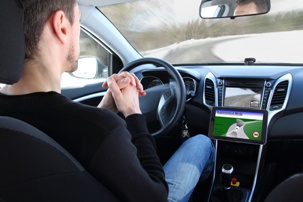Who Can Be Sued When a Driverless Car Causes an Accident?
 In a world where human error accounts for over 90 percent of the world’s car accidents, automated vehicles could save countless lives and prevent millions of injuries. These so-called “driverless” cars are slowly being introduced into the U.S. market, with many automakers claiming that accidents will drop to unprecedented lows. But this technology is not infallible—and when it fails, it may be difficult to determine who is responsible.
In a world where human error accounts for over 90 percent of the world’s car accidents, automated vehicles could save countless lives and prevent millions of injuries. These so-called “driverless” cars are slowly being introduced into the U.S. market, with many automakers claiming that accidents will drop to unprecedented lows. But this technology is not infallible—and when it fails, it may be difficult to determine who is responsible.
Recent “Driverless” Changes in the Automotive Industry
Automation in vehicles isn’t a new phenomenon. Even technology that is now considered “standard,” such as power steering and anti-lock braking, takes partial control of the vehicle away from the driver. Automakers are constantly creating and implementing new ways to take tasks away from the driver, allowing the driver to give more attention to the road. However, the new trend is to relieve the human driver of all tasks, allowing him to essentially act as a passenger in the driver’s seat.
The most recent automated vehicle innovations include:
- Auto parking. Automakers such as BMW and Ford have already implemented hands-free parking, which uses sensors to parallel park the car without any intervention from the driver.
- Auto braking. Some new cars come equipped with crash-imminent braking systems. These automatically apply brakes when the sensors detect a potential obstacle, allowing the driver to avoid a rear-end collision with the car ahead.
- Self driving. While many fully-autonomous vehicles are still in the testing phases, Volvo has recently introduced the first semiautonomous highway driving feature in the U.S. This feature, called Pilot Assist, allows the car to accelerate, brake, maneuver around obstacles, and stay in a lane while traveling up to 80 miles per hour. Pilot Assist relies on a windshield-mounted computer that has radar and a camera, and does not require any driver intervention. However, Volvo does recommend that the human driver remains alert in case the weather changes or visibility is compromised.
- Smart sensors. Many cars include technology that helps the driver navigate safely (such as GPS and backup cameras), but also innovations that can monitor the conditions of a crash. Sensors may alert a driver when they are too close to another vehicle or are drifting out of a lane, allowing a driver to avoid accidents at both city and highway speeds.
Car Manufacturers Ultimately Liable for Automation Injuries
So who pays for damages when an autonomous vehicle crashes? The truth is that these vehicles make some issues clearer (such as fault), but others more complex (such as legal precedent). Laws regarding autonomous vehicles have not yet been created, making these kinds of accident cases new territory for victims and attorneys.
However, these cases may simply take the form of product liability cases rather than car accident claims, as ultimately the software and hardware included in the vehicle is to blame for the crash. Just as a victim would be able to sue an auto parts manufacturer for a faulty airbag, a victim of a driverless car crash could seek compensation if a computer error caused the accident.
When these accidents happen, victims may be able to seek payment for their injuries from:
- Carmakers. Many people believe that car manufacturers will ultimately be liable for any injuries caused by their automated vehicles—and that includes the carmakers themselves. Carmakers such as Volvo, Mercedes, and Google have intimated that they will assume liability if one of their fully autonomous vehicles causes a crash, because the risk of a crash actually occurring will be minimal. What’s more, automakers can still be held accountable for the failures of an automated vehicle under current product liability laws, making it difficult for car companies to escape responsibility for a crash.
- Insurers. Victims may have an easier time collecting insurance payments after a crash in an autonomous vehicle, as the driver’s liability has all but been removed. In addition, sensors and recording devices hardwired into the vehicle enable drivers to give an unbiased and straightforward account of the accident.
- Other parties. These types of accidents may cause new issues in liability, especially if a carmaker can avoid paying accident costs by shifting the blame to one of its contractors. It’s not impossible that computer programmers, software companies, satellite mapping companies, or even state governments may be named in lawsuits.
Do you think automakers should be liable for actions of their driverless cars? Feel free to share this article on Facebook to see what others think of these vehicles.
|
Related Links: |

